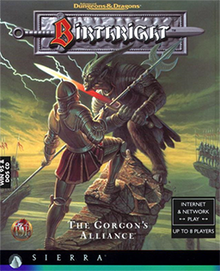
A wargame is a strategy game in which two or more players command opposing armed forces in a simulation of some military operation. Wargaming may be played for recreation, to train military officers in the art of strategic thinking, or to study the nature of potential conflicts. Many wargames re-create specific historic battles, and can cover either whole wars, or any campaigns, battles, or lower-level engagements within them. Many simulate land combat, but there are wargames for naval and air combat, as well.
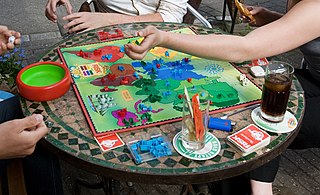
Risk is a strategy board game of diplomacy, conflict and conquest for two to six players. The standard version is played on a board depicting a political map of the world, divided into 42 territories, which are grouped into six continents. Turns rotate among players who control armies of playing pieces with which they attempt to capture territories from other players, with results determined by dice rolls. Players may form and dissolve alliances during the course of the game. The goal of the game is to occupy every territory on the board and, in doing so, eliminate the other players. The game can be lengthy, requiring several hours to multiple days to finish. European versions are structured so that each player has a limited "secret mission" objective that shortens the game.

Myth is a series of real-time tactics video games for Microsoft Windows and Mac OS. There are three main games in the series; Myth: The Fallen Lords, released in 1997, Myth II: Soulblighter, released in 1998, and Myth III: The Wolf Age, released in 2001. The Fallen Lords was developed by Bungie, and published by Bungie in North America and Eidos Interactive in Europe. Soulblighter was also developed by Bungie, and was published by Bungie in North America and GT Interactive in Europe. The Wolf Age was developed by MumboJumbo, and co-published by Take-Two Interactive and Gathering of Developers for Windows and by Take-Two and MacSoft for Mac.
Heroes of Might and Magic, known as Might & Magic Heroes since 2011, is a series of video games originally created and developed by Jon Van Caneghem through New World Computing.

King's Bounty is a turn-based fantasy video game designed by Jon Van Caneghem and published by New World Computing in 1990. The game follows the player's character, a hero of King Maximus, appointed with the job of retrieving the Sceptre of Order from the forces of chaos, led by Arech Dragonbreath. King's Bounty is notably considered the forerunner of the Heroes of Might and Magic series of games.

Master of Magic is a single-player, fantasy turn-based 4X strategy game in which the player plays as a wizard attempting to dominate two linked worlds. From a small settlement, the player manages resources, builds cities and armies, and researches spells, growing an empire and fighting the other wizards.

Warhammer: Shadow of the Horned Rat is a single-player fantasy real-time tactics computer game based upon the Warhammer Fantasy Battle table-top game and miniatures. It was developed and published by Mindscape, and released in November 1995 for Microsoft Windows, and on PlayStation in November 1996. The game's story takes place within the Warhammer Fantasy world setting, and focuses on players managing a group of mercenaries, who take on work for various clients but become involved in stopping a plot by the Skaven. The game's main focus is on battles that feature a mixture of medieval warfare and fantasy elements, using a variety of units based upon those from within the Warhammer setting.
Warlords is a video game series created by Steve Fawkner, in which role-playing elements are combined with turn-based strategy in a fantasy setting. The series began with Warlords in 1990 and includes three other games, two expansion packs, and several spinoffs.
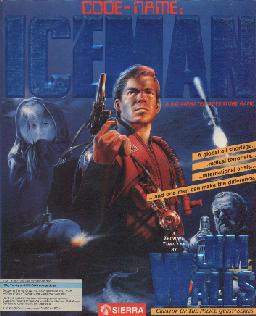
Codename: ICEMAN is a graphical adventure game made with the SCI engine and published by the American computer game company Sierra On-Line in 1989. The lead designer was Jim Walls, who also created several Police Quest games. Mention of a "Codename: PHOENIX" in Sierra promotional material suggests that ICEMAN was meant to be the first part of a Codename series, but disappointing sales ended the would-be franchise after one game.
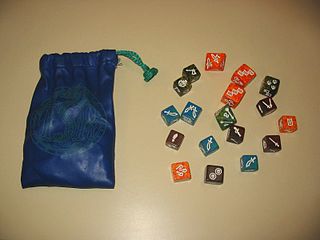
Dragon Dice is a collectible dice game originally made by TSR, Inc., and is produced today by SFR, Inc. It is one of only a handful of collectible dice games produced in the early 1990s. The races and monsters in Dragon Dice were created by Lester Smith and include some creatures unique to a fantasy setting and others familiar to the Dungeons & Dragons role-playing game.
Birthright is a Dungeons & Dragons campaign setting that was first released by TSR in 1995. It is based on the continent of Cerilia on the world of Aebrynis, in which the players take on the role of the divinely-empowered rulers, with emphasis on the political rulership level of gameplay. The setting revolves around the concept of bloodlines: divine power gained by heroes and passed to their descendants. Characters with a bloodline create an aura of command known as Regency, which is measured in the game using regency points or RP. Using regency, characters acquire a domain composed of provinces and holdings. The development of these domains is as much a part of the game as development of the characters. The game uses three-month domain turns to model actions of rulers over nations in much the same way as Dungeons & Dragons uses combat rounds to simulate time to model the characters' actions in battle. In 1996, Birthright won the Origins Award for Best Roleplaying Supplement of 1995.
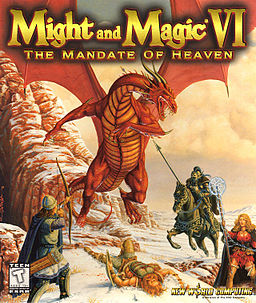
Might and Magic VI: The Mandate of Heaven, commonly abbreviated to Might and Magic VI or simply MM6, is a role-playing video game developed by New World Computing and published by 3DO in 1998. It is the sixth installment in the Might and Magic series, the sequel to Might and Magic V: Darkside of Xeen and the first of the Might and Magic titles to take place on the same planet as Heroes of Might and Magic. It continues the storyline of Heroes of Might and Magic II, and takes place at the same time as Heroes of Might and Magic III in the series chronology. The game was compared favorably to its peers, role-playing video games such as The Elder Scrolls II: Daggerfall. Critics praised it for its non-linear, user-friendly premise, an interactive, detailed game world and a polished, bug-free initial release. A Limited Edition version of the game was also released, including a cloth map of Enroth, a strategy guide and the first five games of the series on CD-ROM. It was followed by three sequels, with Might and Magic VII: For Blood and Honor directly continuing the story arc.

Heroes of Might and Magic II: The Succession Wars is a turn-based strategy video game developed by Jon Van Caneghem through New World Computing and published in 1996 by the 3DO Company. The game is the second instalment of the Heroes of Might and Magic series and is typically credited as the breakout game for the series. Heroes II was voted the sixth-best PC game of all time by PC Gamer in May 1997.

Synergistic Software was a video game developer based in Seattle. Founded in 1978, the company published some of the earliest available games and applications for the Apple II family of computers. They continued developing games for various platforms into the late 1990s.
Real-time tactics (RTT) is a subgenre of tactical wargames played in real-time, simulating the considerations and circumstances of operational warfare and military tactics. It is differentiated from real-time strategy gameplay by the lack of classic resource micromanagement and base or unit building, as well as the greater importance of individual units and a focus on complex battlefield tactics.

Lands of Lore: Guardians of Destiny is a 1997 action role-playing game, second installment of the Lands of Lore series, a sequel to Lands of Lore: The Throne of Chaos. It brought about a drastic change in gameplay style from its predecessor, opting away from the original's D&D turn-based style in favor of more action elements. A sequel, Lands of Lore III, was released in 1999.

MageSlayer is an action video game released in 1997. It was based on the Vampire engine, developed by Raven Software, along with Take No Prisoners. The engine provides a top-down view with 2D sprites for the character and monsters in a full 3D environment with dynamic and colored lighting. The score was composed by Kevin Schilder. MageSlayer marked another Raven Software collaboration with the fantasy artist Brom, who produced the box cover artwork for the game.
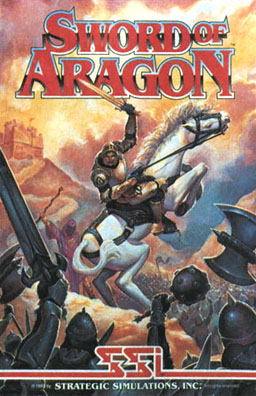
Sword of Aragon is a turn-based strategy and role-playing game developed and published by Strategic Simulations in 1989. It is also considered to be of the 4X genre. Set in the fictional land of Aragon, the games casts its protagonist as the duke of a city named Aladda. After assuming rule over the city and avenging his father's death, the protagonist embarks on a quest to unify the land through conquest. Accomplishing this goal entails developing cities, recruiting armies, and directing the troops on the fields of battle to victory. First published for MS-DOS, the game was ported to Amiga machines. Reception towards Sword of Aragon tended to be more positive than negative; reviewers called it an exciting game, but criticized its method of copy protection and cited problems with its documentation. There were also opinions that the game was more of a niche product, catering to hardcore strategists.

Heroscape is an expandable turn-based miniature wargaming system originally manufactured by Hasbro subsidiaries from 2004 until its discontinuation in November 2010. Geared towards younger players, the game is played using pre-painted miniature figures on a board made from interlocking hexagonal tiles, allowing for the construction of an interchangeable and variable 3D landscape. This system and the relatively high production quality of the game materials have been lauded by fans even years after the game was discontinued.

Chronicles of Osgorth: The Shattered Alliance is a 1981 computer wargame published by Strategic Simulations in January 1982 for the Apple II and Atari 8-bit family. Programmed by John Lyon, it relies on a new game engine, called RapidFire, intended to make faster and easier access to wargames published by the studio. During a turn, the program selects the units each in turn and the player only has to order them to move, attack or cast a spell. The order is then executed immediately before the program selects another unit. The game offers two categories of scenarios. The first is composed of medieval-fantasy confrontation, including a free adaptation of the Battle of Gondor against the Mordor forces in the Lord of the Rings. The second is composed of historical battles of antiquity.
